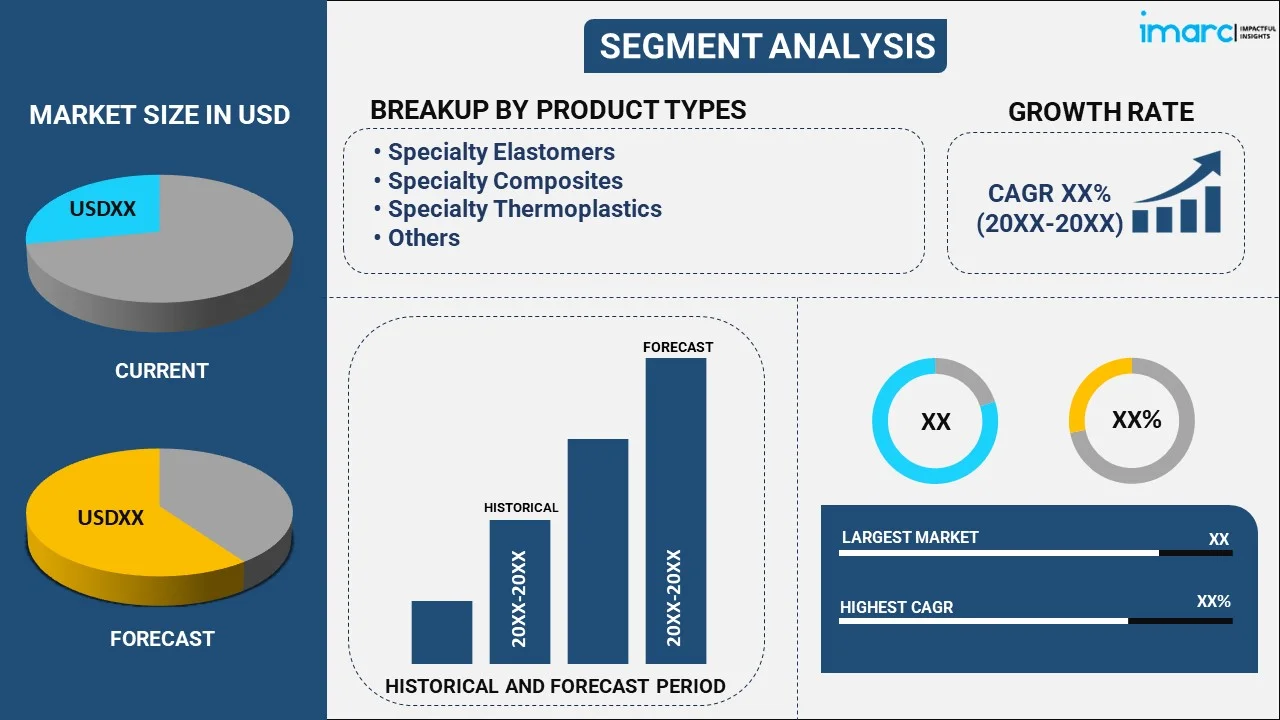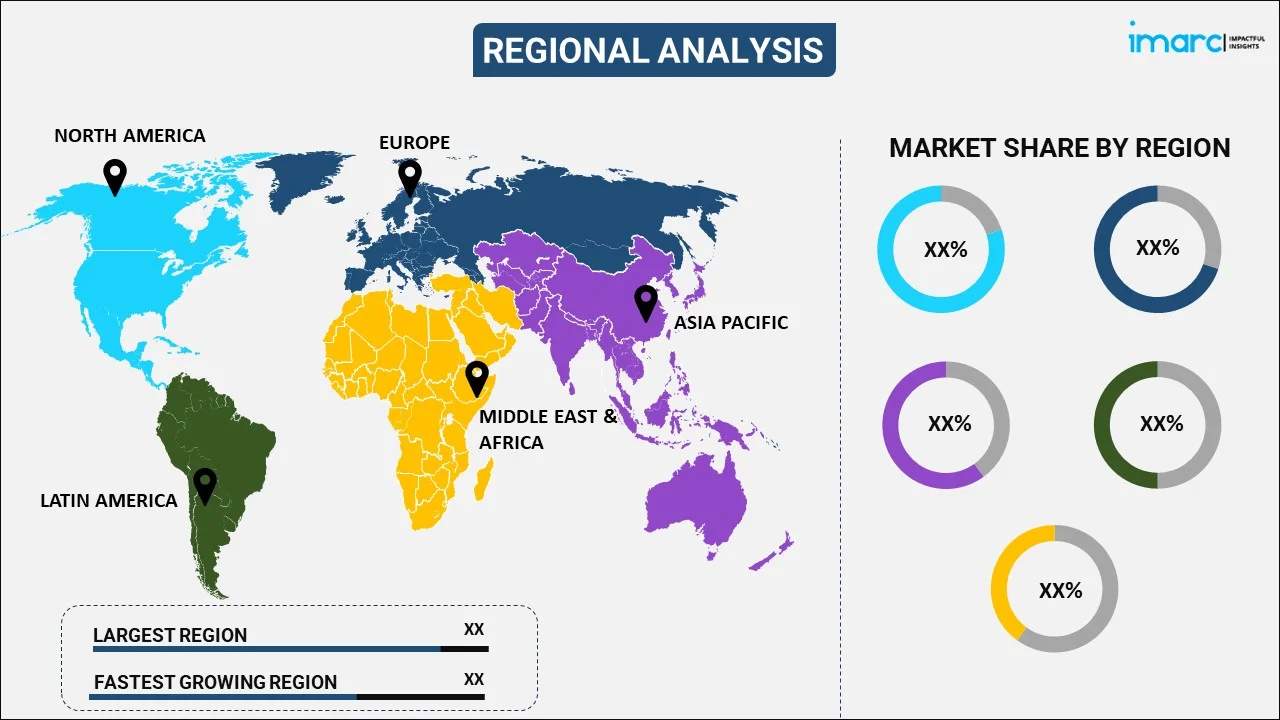
Specialty Polymers Market Report by Product Type (Specialty Elastomers, Specialty Composites, Specialty Thermoplastics, Specialty Thermosets, and Others), End Use Industry (Automotive and Transportation, Consumer Goods, Building and Construction, Coatings, Adhesives, and Sealants, Electrical and Electronics, Healthcare, and Others), and Region 2025-2033
Market Overview:
The global specialty polymers market size reached USD 87.0 Billion in 2024. Looking forward, IMARC Group expects the market to reach USD 150.7 Billion by 2033, exhibiting a growth rate (CAGR) of 5.98% during 2025-2033. The rising automotive demand, increased product use in electronics, emerging need for high-performance materials, elevated packaging applications, and broad adoption in the renewable energy sector are some of the factors contributing to the market growth.
|
Report Attribute
|
Key Statistics
|
|---|---|
|
Base Year
|
2024
|
|
Forecast Years
|
2025-2033
|
|
Historical Years
|
2019-2024
|
|
Market Size in 2024
|
USD 87.0 Billion |
|
Market Forecast in 2033
|
USD 150.7 Billion |
| Market Growth Rate 2025-2033 | 5.98% |
Specialty polymers refer to a class of synthetic materials that have been designed and engineered to possess specific properties and functions for a wide range of industrial and commercial applications. These polymers are typically produced by modifying the chemical structure of the base polymer or by blending two or more different polymers to achieve the desired properties. A variety of distinctive properties, including high strength, durability, chemical resistance, thermal stability, and electrical conductivity, can be seen in specialty polymers. Some commonly used specialty polymers include thermoplastic elastomers (TPEs), fluoropolymers, liquid crystal polymers (LCPs), high-performance polyamides (HPAs), and polyetheretherketones (PEEKs). Specialty polymers are in high demand since they can be employed in many applications where regular polymers aren't appropriate because of processing or performance constraints.

Specialty Polymers Market Trends:
Increased Demand from Automotive Industry
The automotive sector is increasingly turning to specialty polymers to meet evolving regulatory and consumer demands. These materials offer significant advantages in terms of reducing vehicle weight, which is crucial for improving fuel efficiency and lowering emissions. Specialty polymers, such as high-performance thermoplastics and elastomers, are used in various automotive components, including fuel systems, interiors, exteriors, and under-the-hood applications. They are the perfect alternative to conventional metals because of their resistance to mechanical stress, exposure to chemicals, and extremely high temperatures. As electric vehicles (EVs) gain momentum, the demand for specialty polymers is further accelerating. EVs require lightweight materials to offset the weight of heavy batteries, and specialty polymers provide the necessary strength and flexibility. Moreover, these materials improve vehicle safety by enhancing impact resistance and reducing noise and vibration.
Rising Use in Electronics
The electronics industry relies heavily on these materials for producing advanced devices with higher performance and longer life spans, which, in turn, is boosting the specialty polymers market share. These materials are crucial for insulating and protecting sensitive components in smartphones, tablets, computers, and other consumer electronics. Polymers like polyimides, polycarbonates, and polyethylene terephthalate (PET) offer excellent electrical insulation, thermal stability, and resistance to harsh environmental conditions. With the demand for miniaturization of electronic devices, specialty polymers play a critical role in ensuring that smaller components can function without overheating or becoming damaged. They also enhance the durability and flexibility of wearable devices, sensors, and other emerging technologies. The shift towards fifth-generation (5G) technology and the Internet of Things (IoT) is driving the need for more advanced materials to handle increased data processing speeds, power demands, and connectivity.
Growing Demand for High-performance Materials
According to the latest specialty polymers market report, various industries, including aerospace, medical, and construction, are increasingly relying on these materials for high-performance applications where standard materials fall short. Aerospace, in particular, demands materials that are lightweight yet incredibly strong and resistant to extreme temperatures and corrosive environments. Specialty polymers such as polyether ether ketone (PEEK) and polyphenylene sulfide (PPS) meet these requirements, offering durability without adding excessive weight. In the medical sector, specialty polymers are used in the manufacturing of devices like catheters, implants, and surgical instruments. Their biocompatibility, flexibility, and resistance to chemicals make them ideal for medical applications where precision and safety are paramount. Specialty polymers also find widespread use in construction, where they are favored for their durability, resistance to moisture, and ability to withstand harsh weather conditions.
Specialty Polymers Market Segmentation:
IMARC Group provides an analysis of the key trends in each segment of the global specialty polymers market, along with forecasts at the global, regional, and country levels from 2025-2033. Our report has categorized the market based on the product type and end use industry.
Product Type Insights:

- Specialty Elastomers
- Fluoroelastomers
- Fluorosilicone Rubber
- Liquid Silicone Rubber
- Natural Rubber
- Others
- Specialty Composites
- Particle Reinforced Composites
- Fiber Reinforced Composites
- Structural Composites
- Specialty Thermoplastics
- Polyolefins
- Polyimides
- Vinyl Polymer
- Polyphenols
- Others
- Specialty Thermosets
- Epoxy
- Polyester
- Vinyl Ester
- Polyimides
- Others
- Others
The report has provided a detailed breakup and analysis of the specialty polymers market based on the product type. This includes specialty elastomers (fluoroelastomers, fluorosilicone rubber, liquid silicone rubber, natural rubber, and others), specialty composites (particle reinforced composites, fiber reinforced composites, and structural composites), specialty thermoplastics (polyolefins, polyimides, vinyl polymer, polyphenols, and others), specialty thermosets (epoxy, polyester, vinyl ester, polyimides, and others), and others. According to the report, specialty elastomers (fluoroelastomers, fluorosilicone rubber, liquid silicone rubber, natural rubber, and others) represented the largest segment.
End Use Industry Insights:
- Automotive and Transportation
- Consumer Goods
- Building and Construction
- Coatings, Adhesives, and Sealants
- Electrical and Electronics
- Healthcare
- Others
A detailed breakup and analysis of the specialty polymers market based on the end use industry has also been provided in the report. This includes automotive and transportation, consumer goods, building and construction, coatings, adhesives, and sealants, electrical and electronics, and healthcare, and others. According to the report, automotive and transportation accounted for the largest market share.
Regional Insights:

- North America
- United States
- Canada
- Asia-Pacific
- China
- Japan
- India
- South Korea
- Australia
- Indonesia
- Others
- Europe
- Germany
- France
- United Kingdom
- Italy
- Spain
- Russia
- Others
- Latin America
- Brazil
- Mexico
- Others
- Middle East and Africa
The report has also provided a comprehensive analysis of all the major regional markets, which include North America (the United States and Canada); Europe (Germany, France, the United Kingdom, Italy, Spain, Russia, and others); Asia Pacific (China, Japan, India, South Korea, Australia, Indonesia, and others); Latin America (Brazil, Mexico, and others); and the Middle East and Africa. According to the report, Asia Pacific was the largest market for specialty polymers. Some of the factors driving the Asia Pacific specialty polymers market included growing product demand from end-use industries, expanding disposable income levels, and rapid urbanization.
Competitive Landscape:
The report has also provided a comprehensive analysis of the competitive landscape in the global specialty polymers market. Detailed profiles of all major companies have also been provided. Some of the companies covered include:
- 3M Company
- A. Schulman Inc. (LyondellBasell Industries N.V.)
- Arkema S.A.
- Ashland Inc.
- Avient Corporation
- BASF SE
- Croda International Plc
- Dow Inc.
- Evonik Industries AG
- Koninklijke DSM N.V.
- Solvay S.A.
- Specialty Polymers Inc. (The Sherwin-Williams Company)
Kindly note that this only represents a partial list of companies, and the complete list has been provided in the report.
Specialty Polymers Market News:
- In May 2024, LyondellBasell, a German company, launched waste-based polymers to support a circular economy and reduce reliance on fossil-based raw materials, aligning with the growing environmental and sustainability goals in Europe.
Report Coverage:
| Report Features | Details |
|---|---|
| Base Year of the Analysis | 2024 |
| Historical Period | 2019-2024 |
| Forecast Period | 2025-2033 |
| Units | Billion USD |
| Product Types Covered |
|
| End Use Industries Covered | Automotive and Transportation, Consumer Goods, Building and Construction, Coatings, Adhesives, and Sealants, Electrical and Electronics, Healthcare, and Others |
| Regions Covered | Asia Pacific, Europe, North America, Latin America, Middle East and Africa |
| Countries Covered | United States, Canada, Germany, France, United Kingdom, Italy, Spain, Russia, China, Japan, India, South Korea, Australia, Indonesia, Brazil, Mexico |
| Companies Covered | 3M Company, A. Schulman Inc. (LyondellBasell Industries N.V.), Arkema S.A., Ashland Inc., Avient Corporation, BASF SE, Croda International Plc, Dow Inc., Evonik Industries AG, Koninklijke DSM N.V., Solvay S.A., Specialty Polymers Inc. (The Sherwin-Williams Company), etc. |
| Customization Scope | 10% Free Customization |
| Post-Sale Analyst Support | 10-12 Weeks |
| Delivery Format | PDF and Excel through Email (We can also provide the editable version of the report in PPT/Word format on special request) |
Key Questions Answered in This Report:
- How has the global specialty polymers market performed so far, and how will it perform in the coming years ?
- What are the drivers, restraints, and opportunities in the global specialty polymers market ?
- What is the impact of each driver, restraint, and opportunity on the global specialty polymers market ?
- What are the key regional markets ?
- Which countries represent the most attractive specialty polymers market ?
- What is the breakup of the market based on the product type ?
- Which is the most attractive product type in the specialty polymers market ?
- What is the breakup of the market based on the end use industry ?
- Which is the most attractive end use industry in the specialty polymers market ?
- What is the competitive structure of the global specialty polymers market ?
- Who are the key players/companies in the global specialty polymers market ?
Key Benefits for Stakeholders:
- IMARC’s report offers a comprehensive quantitative analysis of various market segments, historical and current market trends, market forecasts, and dynamics of the specialty polymers market from 2019-2033.
- The research study provides the latest information on the market drivers, challenges, and opportunities in the global specialty polymers market.
- The study maps the leading, as well as the fastest-growing, regional markets. It further enables stakeholders to identify the key country-level markets within each region.
- Porter's five forces analysis assist stakeholders in assessing the impact of new entrants, competitive rivalry, supplier power, buyer power, and the threat of substitution. It helps stakeholders to analyze the level of competition within the specialty polymers industry and its attractiveness.
- Competitive landscape allows stakeholders to understand their competitive environment and provides an insight into the current positions of key players in the market.
Need more help?
- Speak to our experienced analysts for insights on the current market scenarios.
- Include additional segments and countries to customize the report as per your requirement.
- Gain an unparalleled competitive advantage in your domain by understanding how to utilize the report and positively impacting your operations and revenue.
- For further assistance, please connect with our analysts.
 Inquire Before Buying
Inquire Before Buying
 Speak to an Analyst
Speak to an Analyst
 Request Brochure
Request Brochure
 Request Customization
Request Customization




.webp)




.webp)












